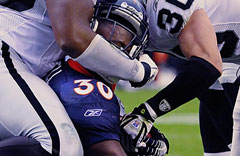 Hi and welcome to this edition of Workshop at the Ranch. Nikon’s D3 digital SLR camera is the talk of the town and I was thrilled to be one of the photographers hired to make images for Nikon’s D3 brochure, catalog and public relations pieces.
Hi and welcome to this edition of Workshop at the Ranch. Nikon’s D3 digital SLR camera is the talk of the town and I was thrilled to be one of the photographers hired to make images for Nikon’s D3 brochure, catalog and public relations pieces.
Let me say that I believe the Nikon D3 digital SLR camera will encourage photographers to think in new and creative ways. There are so many advancements in this camera that photographers of all subject matter, whether it be photojournalism, sports, weddings, landscapes, portraits, etc. will all benefit from the revolutionary technology that the D3 offers.
Hi and welcome to this edition of Workshop at the Ranch. Nikon’s D3 digital SLR camera is the talk of the town and I was thrilled to be one of the photographers hired to make images for Nikon’s D3 brochure, catalog and public relations pieces.
Let me say that I believe the Nikon D3 digital SLR camera will encourage photographers to think in new and creative ways. There are so many advancements in this camera that photographers of all subject matter, whether it be photojournalism, sports, weddings, landscapes, portraits, etc. will all benefit from the revolutionary technology that the D3 offers.
There are many articles and opinions one can read online but only a few photographers have had the opportunity to actually use the D3 on a daily basis. I have spent the better part of the last 3 months using the D3 in a variety of situations ranging from sports to landscapes to lightpaintings I have made 24X36 print enlargements and had numerous pictures published and the comments are always the same, …REMARKABLE, INCREDIBLE, UNBELIEVABLE. At Nikon’s request I was asked to photograph sports under difficult low light situations in gymnasiums, ice halls and outdoor venues with the new D3. I photographed several sports including ice hockey, basketball, motor sports, water sports, gymnastics and figure skating, but for this month’s Workshop at the Ranch I chose to stay in season and showcase some images I made during football game coverage over the past few weeks. This month’s On The Road article will also address the Nikon D3 with both images and commentary and will feature landscapes and Lightpaintings made with the D3.
Before we look at some pictures I’d like to point out some of the new features of the Nikon D3 digital SLR camera and inject a short comment about each. My comments are my own and are based on my experience using the D3 on location and assignments during the last three months. With this in mind, let’s find out what people are claiming to be an extraordinary industry breakthrough camera.
1. The 12.1 megapixel Nikon FX Format CMOS Imaging Sensor is key to this camera’s success. It says 12.1 megapixels but the D3 clearly produces images with quality that one might think came from a camera with 17 megapixels. There is much more detail, clarity, depth of pixel and dynamic range than any 12.1 megapixel camera has ever had before. I like the fact that the file size has remained similar to a D2X but the quality of the file has greatly increased and is evident in both the print form and in published materiel. It is the new Nikon FX Format CMOS imaging sensor that makes the next breakthrough feature possible.
2. The exceptionally clean high ISO sensitivity performance at up to ISO 6400. UNBELIEVABLE! You have to see it to believe it. The extremely low noise at ISO6400 is perhaps the calling card of the Nikon D3. Making impossible situations possible the ISO of 6400 is not just usable, it is BEAUTIFUL and easily publishable for magazine covers and double page spreads. The noise level is so low and minimal at ISO3200 and ISO6400 that words like incredible or astonishing still fall short of truly describing the quality of the image.
3. Nine, YES!… 9 Frames per second of continuous shooting. This fast frame rate often times makes the difference between capturing the moment and going back to the editor empty handed.
4. 3D Focus Tracking system is no less than remarkable. It works! I thought that this 51 point focus tracking system might become confused and follow other players with the same uniform within the frame but that was not the case. Thanks to the new Nikon Signature Recognition System and 3D Focus Tracking picking up a wide receiver diving through the air will be much easier to capture for all of us working on the sidelines.
5. The 3 inch Super Density 920,000 dot VGA color LCD monitor. This new super monitor makes viewing images in daylight possible. It’s like having Hi Def in the palm of your hand. The Zoom tool for closer viewing of an image is fast and accurate making it easy to determine the finer details of a picture. “Chimping”, as picture review is sometimes called amongst sports photographers, will take on a whole new meaning with this Super Density LCD monitor.
Dual Compact Flash Card Slots, Picture Control Settings, Live View, etc., etc. I could talk forever but pictures say it all. Let’s have a look at some images captured with the new Nikon D3…..
|
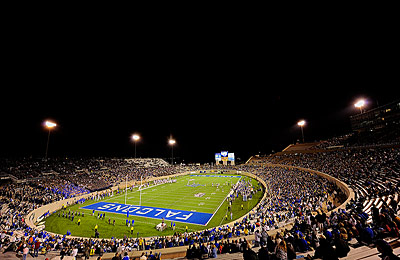 Image #1. Night Game … All sports photographers are faced with more night time games under the lights. The Nikon D3 camera with its extremely clean high ISO capabilities of 1600, 3200, 6400 and yes, even higher, makes both the indoor gymnasiums and outdoor nighttime sports a joy to photograph. I had to see it to believe it and I was amazed at the clean file and beautiful detail I could capture at extremely high ISO levels. Nikon D3, ISO1600, 1/400 at f5.6, Nikon 14-24mm f2.8 Lens, WB Auto, Lexar 8G Flash Card. Image #1. Night Game … All sports photographers are faced with more night time games under the lights. The Nikon D3 camera with its extremely clean high ISO capabilities of 1600, 3200, 6400 and yes, even higher, makes both the indoor gymnasiums and outdoor nighttime sports a joy to photograph. I had to see it to believe it and I was amazed at the clean file and beautiful detail I could capture at extremely high ISO levels. Nikon D3, ISO1600, 1/400 at f5.6, Nikon 14-24mm f2.8 Lens, WB Auto, Lexar 8G Flash Card.
|
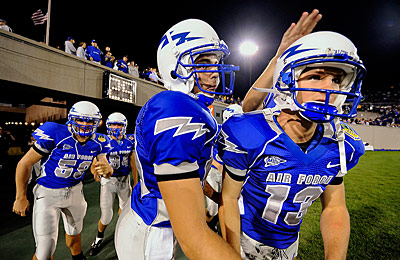 Image #2. Falcons Take the Field … Players running onto the field is always exciting. Usually I would have used an SB800 Speedlight to help illuminate the players in this dark area of the stadium but ISO3200 produced an almost noiseless image. The Auto White Balance did a great job of keeping true color even with typical college stadium lighting. Nikon D3, ISO3200, 1/500 at f4, Nikon 14-24mm f2.8 Lens, 3D Focus Tracking, WB Auto, Lexar 8G Flash card. Image #2. Falcons Take the Field … Players running onto the field is always exciting. Usually I would have used an SB800 Speedlight to help illuminate the players in this dark area of the stadium but ISO3200 produced an almost noiseless image. The Auto White Balance did a great job of keeping true color even with typical college stadium lighting. Nikon D3, ISO3200, 1/500 at f4, Nikon 14-24mm f2.8 Lens, 3D Focus Tracking, WB Auto, Lexar 8G Flash card.
|
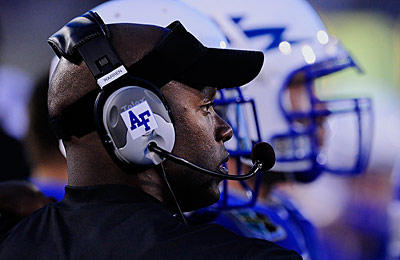 Image #3. Sideline Thoughts … The bench area is certainly darker than the playing field. Coach Warren is an African American with very dark skin and is wearing a black shirt and black visor. The increased dynamic range of the D3 easily reveals the shadow detail and even the cotton mesh of his black shirt. Nikon D3, ISO6400, 1/1000 at f4.0, Nikon 400mm G VR f2.8 Lens with Nikon TC14E 1.4 Teleconverter, 3D Focus Tracking, WB Auto, Lexar 8G Flash Card. Image #3. Sideline Thoughts … The bench area is certainly darker than the playing field. Coach Warren is an African American with very dark skin and is wearing a black shirt and black visor. The increased dynamic range of the D3 easily reveals the shadow detail and even the cotton mesh of his black shirt. Nikon D3, ISO6400, 1/1000 at f4.0, Nikon 400mm G VR f2.8 Lens with Nikon TC14E 1.4 Teleconverter, 3D Focus Tracking, WB Auto, Lexar 8G Flash Card.
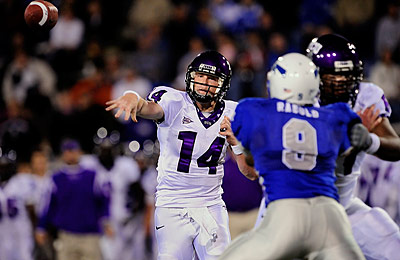 Image #4A. Screen Pass … TCU has a strong air attack and quarterback Andy Dalton throws the screen pass on a frozen rope to his receivers. The advantage of ISO6400 allows me to use a fast shutter speed of 1/1250 which stops the action, including the ball, perfectly and I have more depth of field at f5. Nikon D3, ISO6400, 1/1250 at f5, Nikon 400mm G VR f2.8 Lens with TC14E 1.4 Teleconverter, 3D Focus Tracking, WB Auto, Lexar 8G Flash Card. Image #4A. Screen Pass … TCU has a strong air attack and quarterback Andy Dalton throws the screen pass on a frozen rope to his receivers. The advantage of ISO6400 allows me to use a fast shutter speed of 1/1250 which stops the action, including the ball, perfectly and I have more depth of field at f5. Nikon D3, ISO6400, 1/1250 at f5, Nikon 400mm G VR f2.8 Lens with TC14E 1.4 Teleconverter, 3D Focus Tracking, WB Auto, Lexar 8G Flash Card. |
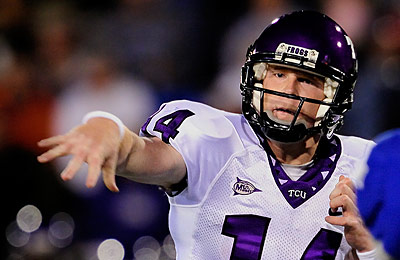 Image #4B. Screen Pass (close up cropped detail) … I have cropped the image for a closer study. This cropped enlargement of the previous image illustrates the extremely low noise performance at ISO6400. Clean, sharp and loaded with edge detail even this extreme cropped image is publishable. Image #4B. Screen Pass (close up cropped detail) … I have cropped the image for a closer study. This cropped enlargement of the previous image illustrates the extremely low noise performance at ISO6400. Clean, sharp and loaded with edge detail even this extreme cropped image is publishable. 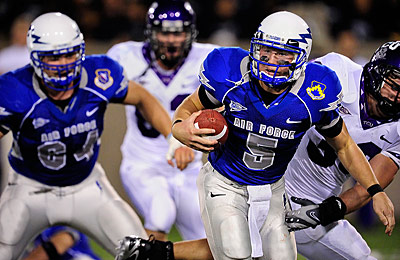 Image #5A Quarterback Option … The fact that the Nikon D3 produces a very clean low noise image at ISO settings like 1600, 3200 and 6400 is truly remarkable, but I didn’t stop there ……… how about ISO12,800! Yes, it is possible and it looks quite good. Referred to in the manual as “Hi 1” the noise produced is still well within reason. I found this Hi 1 setting very acceptable and I will not hesitate using the Hi 1 ISO12,800 setting for extremely dark venues like a High School football field, baseball park, tennis court or indoor gymnasium. It looks good, produces great print quality and will publish in both newspapers and magazines well. Exceeding the ISO6400 threshold is a reality with this camera. As with most stadiums the light diminishes near and into the end zones. For this image the Hi 1 ISO12,800 setting allowed me to maintain both a fast shutter speed and strong depth of field despite the lower light level near the end zone. Nikon D3, ISO12,800 (Hi 1), 1/1250 at f5.6, Nikon 400mm G VR f2.8 Lens with TC14E 1.4 Teleconverter, WB Auto, Lexar 8G Flash Card. Image #5A Quarterback Option … The fact that the Nikon D3 produces a very clean low noise image at ISO settings like 1600, 3200 and 6400 is truly remarkable, but I didn’t stop there ……… how about ISO12,800! Yes, it is possible and it looks quite good. Referred to in the manual as “Hi 1” the noise produced is still well within reason. I found this Hi 1 setting very acceptable and I will not hesitate using the Hi 1 ISO12,800 setting for extremely dark venues like a High School football field, baseball park, tennis court or indoor gymnasium. It looks good, produces great print quality and will publish in both newspapers and magazines well. Exceeding the ISO6400 threshold is a reality with this camera. As with most stadiums the light diminishes near and into the end zones. For this image the Hi 1 ISO12,800 setting allowed me to maintain both a fast shutter speed and strong depth of field despite the lower light level near the end zone. Nikon D3, ISO12,800 (Hi 1), 1/1250 at f5.6, Nikon 400mm G VR f2.8 Lens with TC14E 1.4 Teleconverter, WB Auto, Lexar 8G Flash Card.
  Image #5B Quarterback Option (close up cropped detail) … I have cropped the image for a closer study. This cropped enlargement of the previous image illustrates that even at the “Hi 1” ISO12,800 setting the noise level is very acceptable and easily suitable for publishing and print making. I have not used the Hi 2 ISO25,600 setting … not yet that Image #5B Quarterback Option (close up cropped detail) … I have cropped the image for a closer study. This cropped enlargement of the previous image illustrates that even at the “Hi 1” ISO12,800 setting the noise level is very acceptable and easily suitable for publishing and print making. I have not used the Hi 2 ISO25,600 setting … not yet that |
|
|
I have heard some some photographers compare the noise level of a Nikon D3 file at ISO6400 to resemble the ISO400 setting of a D2Xs. This is probably a fair statement, but, my findings are that only the shadow areas resemble ISO400 and that the lit areas look even better. This brings up a good question…”Why even use a lower ISO. Can I shoot at ISO6400 all the time?” Well, even though the quality at ISO6400 looks fantastic, there is a difference between ISO200 and ISO6400. Given that the photographer has made an accurate exposure, the Nikon D3’s ISO200-800 is absolutely stunning, just STUNNING and looks better than low ISO settings in a D2Xs. The D3’s ISO1000-1250 is also beautiful and virtually noise free with only a slight touch of noise in the deep shadows but even that slight amount of noise is hardly noticeable. ISO1600 has incredibly low noise and ISO1600 is cleaner than 3200 and 3200 is cleaner than 6400, the differences are minimal as you dial up from 1600 to 3200 and from 3200 to 6400. But, and let me again emphasis this point, the D3 file at ISO6400 resembles the ISO400 setting in a D2Xs. My thoughts are if a lighting situation calls for a lower ISO then use a lower ISO because the quality of the file will blow you away, but when the lighting situation calls for a higher ISO then use a higher ISO because the quality will also blow you away. Just because ISO3200 and 6400 look great even in bright sunshine should not detour the photographer from using a lower ISO like 200, 400 or even 800 when it is called for because it does look better than 1600, 3200 or 6400. Hey! Read that again!, “a LOWER ISO of 400 or even 800,” that’s how astonishing the D3 file looks! With the Nikon D3 camera ISO400 and ISO800 will now be considered LOW ISO settings.But, because ISO3200 and 6400 does look so good, think about this………….The fact that ISO3200 and ISO6400 look great even in bright sunshine opens up the doors of possibility. Think of it, Priority modes take on a new dimension. Contending with the football stadium shadow is aggravating at best for all of us who shoot sports. The play starts in brilliant sunshine and ends in the shadow of the stadium which is almost 4 stops darker and for some reason it’s always the key play of the game. Solution, Example #1: Using Shutter Priority mode on a sunny day I can set my shutter speed at 1/1250 to stop the action while setting my ISO at 3200 for the possibility of the play moving into the stadium shadow and still have uncompromised quality. My aperture adjusts automatically to f22 for the bright sunshine and as a play moves from the sunshine to the stadium shadow my aperture will adjust automatically to f6.3. But, it gets even better. Example #2: The D3 allows me to activate an Auto ISO mode which allows me to set my shutter speed and aperture at specific settings, then the ISO will adjust automatically as the light changes. In other words, if I set my shutter and aperture accordingly at 1/1250 at f6.3 then the auto ISO adjusts automatically for the lighting condition. The play begins in the sunlight at auto ISO250 with stunning quality. The play progresses and ends in the shadow of the stadium and my shutter and aperture remain where I set them, 1/1250 at f6.3 but my auto ISO has automatically adjusted for the dark stadium shadow to ISO3200 with minimal noise increase. YES! The entire play will be perfectly exposed start to finish. I have stunning quality in the sunlit images at the start of the play and uncompromised quality in the dark stadium shadow images at the end of the play. So many great pictures are lost during the exposure transition a football play makes from sunshine to shadow or as clouds pass over head. This is a real advantage in my opinion and is why I say that photographers will be encouraged to think in new and creative ways with the Nikon D3.
|
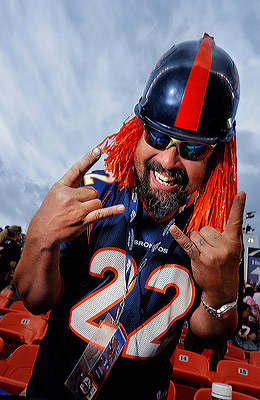 Image #6. Foul Weather Fan … Although the match up with Denver vs Oakland was a Sunday afternoon game, those who were there will echo my opinion that it was one of the darkest day games in recent NFL history … just what I wanted. This fan was enjoying the game when lightning inspired officials to delay the game until a micro burst thunder storm passed through the Denver area. The over cast conditions were dark enough that ISO1000 was needed for this on the run fan portrait as I ran for the tunnel to escape the lightning. Nikon D3, ISO1000, 1/640 at f5, Nikon 24-70mm f2.8 Lens, WB 4000K, One Nikon SB800 with Warming Gel at power output of +0.7 hand held as a remote off camera flash, Nikon SU800 Commander to trigger the Remote SB800, Lexar 8G Flash Card. Image #6. Foul Weather Fan … Although the match up with Denver vs Oakland was a Sunday afternoon game, those who were there will echo my opinion that it was one of the darkest day games in recent NFL history … just what I wanted. This fan was enjoying the game when lightning inspired officials to delay the game until a micro burst thunder storm passed through the Denver area. The over cast conditions were dark enough that ISO1000 was needed for this on the run fan portrait as I ran for the tunnel to escape the lightning. Nikon D3, ISO1000, 1/640 at f5, Nikon 24-70mm f2.8 Lens, WB 4000K, One Nikon SB800 with Warming Gel at power output of +0.7 hand held as a remote off camera flash, Nikon SU800 Commander to trigger the Remote SB800, Lexar 8G Flash Card. |
|
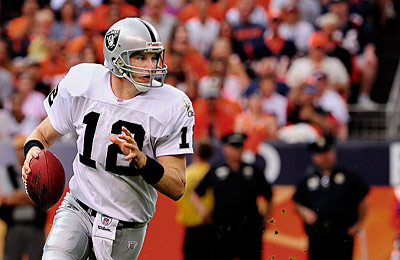 Image #7A. Scramble … Raiders’ quarterback, Josh McCowen was on the run looking for receivers several times during the course of the game. I had learned a lot about the D3’s low noise capabilities at high ISO levels during the Air Force night game and so I wasted no time in dialing up to ISO6400. With some ambient light from the overcast skies combined with the stadium lights I knew that ISO6400 would be very clean and allow me to increase my shutter speed to 1/1600 to freeze the action and set my aperture at f7.1 for more depth of field. Beautiful results. Even the shadows have plenty of detail. The 3D Focus Tracking system worked flawlessly and followed my subject both in the open field and when surrounded by teammates. I could even recompose the image while my subject was on the run as the focus point tracked McCowen perfectly. For this image I let my subject run into the left side of the frame leaving plenty of room for an editor to place copy yet the image has so much quality that it could easily be cropped as a tight vertical for a cover. If only it was Kenny Stabler. Nikon D3, ISO6400, 1/1600 at f7.1, Nikon 400mm f2.8 G VR Lens with TC14E 1.4 Teleconverter, 3D Focus Tracking, WB Auto, Lexar 8G Flash Card. Image #7A. Scramble … Raiders’ quarterback, Josh McCowen was on the run looking for receivers several times during the course of the game. I had learned a lot about the D3’s low noise capabilities at high ISO levels during the Air Force night game and so I wasted no time in dialing up to ISO6400. With some ambient light from the overcast skies combined with the stadium lights I knew that ISO6400 would be very clean and allow me to increase my shutter speed to 1/1600 to freeze the action and set my aperture at f7.1 for more depth of field. Beautiful results. Even the shadows have plenty of detail. The 3D Focus Tracking system worked flawlessly and followed my subject both in the open field and when surrounded by teammates. I could even recompose the image while my subject was on the run as the focus point tracked McCowen perfectly. For this image I let my subject run into the left side of the frame leaving plenty of room for an editor to place copy yet the image has so much quality that it could easily be cropped as a tight vertical for a cover. If only it was Kenny Stabler. Nikon D3, ISO6400, 1/1600 at f7.1, Nikon 400mm f2.8 G VR Lens with TC14E 1.4 Teleconverter, 3D Focus Tracking, WB Auto, Lexar 8G Flash Card.
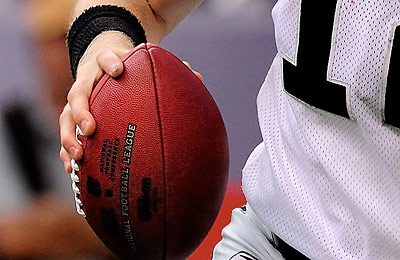 Image #7B. Scramble (close up cropped detail) … I have cropped the image for a closer study. The high ISO of 6400 looked very clean throughout the image and allowed me to use an aperture setting of f7.1 creating a broader depth of field. This cropped detail of the previous image illustrates the beautiful edge detail and minimal noise even when using ISO6400. The stitching on the laces of the football are visible and McCowen has a small blood blister under his index finger nail. That is fabulous detail provided by the new 12.1 megapixel Nikon FX Format CMOS Imaging Sensor. Image #7B. Scramble (close up cropped detail) … I have cropped the image for a closer study. The high ISO of 6400 looked very clean throughout the image and allowed me to use an aperture setting of f7.1 creating a broader depth of field. This cropped detail of the previous image illustrates the beautiful edge detail and minimal noise even when using ISO6400. The stitching on the laces of the football are visible and McCowen has a small blood blister under his index finger nail. That is fabulous detail provided by the new 12.1 megapixel Nikon FX Format CMOS Imaging Sensor.
|
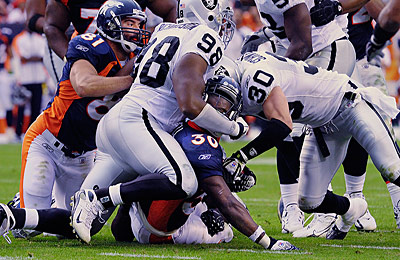 Image #8A. Head Strong … Denver running back Mike Bell finds yardage inside the 5 yard line difficult to acquire in the fourth quarter. Thanks to the lightning storm delay it is now early evening and the available light in the sky is providing very little additional illumination to the field. The stadium lights are dominating my exposure as I can now see the shadow of the face mask on a player’s cheek and nose. This play is near the goal line where the stadium light tends to diminish. Using ISO6400 and the 3D Focus Tracking system I was able to follow Bell through the line of Oakland defensemen and Denver blockers. The file is very clean with only minimal noise and even that low level of noise is in the shadow area. It is amazing! Nikon D3, ISO6400, 1/1250 at f6.3, Nikon 400mm f2.8 G VR Lens with TC14E 1.4 Teleconverter, 3D Focus tracking, WB Auto, Lexar 8G Flash Card. Image #8A. Head Strong … Denver running back Mike Bell finds yardage inside the 5 yard line difficult to acquire in the fourth quarter. Thanks to the lightning storm delay it is now early evening and the available light in the sky is providing very little additional illumination to the field. The stadium lights are dominating my exposure as I can now see the shadow of the face mask on a player’s cheek and nose. This play is near the goal line where the stadium light tends to diminish. Using ISO6400 and the 3D Focus Tracking system I was able to follow Bell through the line of Oakland defensemen and Denver blockers. The file is very clean with only minimal noise and even that low level of noise is in the shadow area. It is amazing! Nikon D3, ISO6400, 1/1250 at f6.3, Nikon 400mm f2.8 G VR Lens with TC14E 1.4 Teleconverter, 3D Focus tracking, WB Auto, Lexar 8G Flash Card.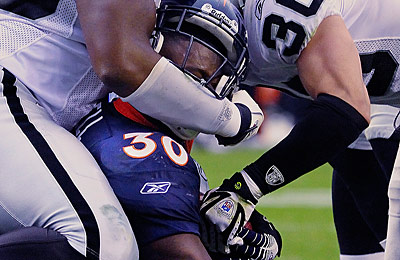
Image #8B. Head Strong (close up cropped detail) … I have cropped the image for a closer study. The cropped enlargement shows great details with all the trademarks, logos, stitching and mesh jersey material clearly visible. The noise is minimal even in the shadow areas and the 3D Focus Tracking has stayed with Bell throughout the play. |
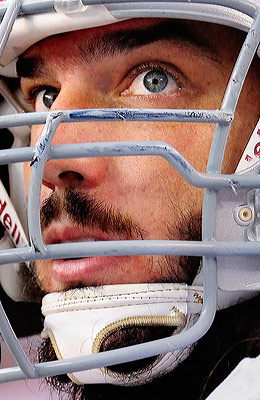 Image #9A. The Raider Image … Oakland’s left guard Robert Gallery’s long hair and lengthy beard speaks to the Raider image and Oakland football history. I photographed Gallery during the 4th quarter in the bench area where the stadium light tends to fall off. Nikon D3, ISO6400, 1/1000 at f6.3, Nikon 400mm f2.8 G VR Lens with TC14E 1.4 Teleconverter, 3D Focus Tracking, WB Auto, Lexar 8G Flash Card. Image #9A. The Raider Image … Oakland’s left guard Robert Gallery’s long hair and lengthy beard speaks to the Raider image and Oakland football history. I photographed Gallery during the 4th quarter in the bench area where the stadium light tends to fall off. Nikon D3, ISO6400, 1/1000 at f6.3, Nikon 400mm f2.8 G VR Lens with TC14E 1.4 Teleconverter, 3D Focus Tracking, WB Auto, Lexar 8G Flash Card.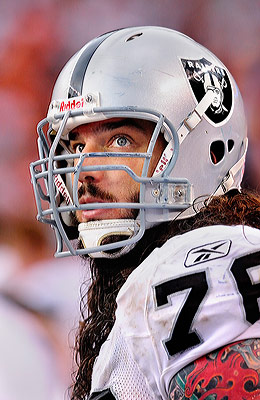 Image #9B. The Raider Image (close up cropped detail) … I have cropped the image for a closer study. This cropped detail enlargement again illustrates the quality of image that the Nikon D3 produces at the high ISO of 6400. Usually the sports photographer is working with the widest open aperture setting possible during a game under the lights. A wide open aperture has a very short depth of field and with a 400mm or 600mm lens this short depth of field might only be a few inches of focus on my subject. I could have reduced the ISO to a lower setting but I wanted an aperture that would give me more depth of field so that not only would his left eye be in focus but his right eye, beard and face mask as well. There is a difference in noise level from 3200 to 6400 but it is not that significant. This cropped enlargement is easily suitable for publishing, even on the cover. Image #9B. The Raider Image (close up cropped detail) … I have cropped the image for a closer study. This cropped detail enlargement again illustrates the quality of image that the Nikon D3 produces at the high ISO of 6400. Usually the sports photographer is working with the widest open aperture setting possible during a game under the lights. A wide open aperture has a very short depth of field and with a 400mm or 600mm lens this short depth of field might only be a few inches of focus on my subject. I could have reduced the ISO to a lower setting but I wanted an aperture that would give me more depth of field so that not only would his left eye be in focus but his right eye, beard and face mask as well. There is a difference in noise level from 3200 to 6400 but it is not that significant. This cropped enlargement is easily suitable for publishing, even on the cover. |
This Workshop at the Ranch article can only whet the appetite of a sports photographer who covers night time sports events and indoor arena and gymnasium competitions on a regular basis. You must see it to believe it when it comes to the remarkably clean D3 image at high ISO settings of ISO1600, 3200 and 6400. The precise accuracy of the 3D Focus Tracking System and the incredible pixel quality, detail and dynamic range that this camera offers is outstanding. These industry breakthroughs plus a blazing 9 frames/second continuous shooting make this the most complete sports photojournalism camera ever, but the possibilities extend beyond sports coverage and to all subjects of photography. Wedding photographers are always contending with difficult situations involving candlelight and dark reception halls. Nature and Landscape photographers often times pack up and leave the location when it is too overcast or windy but now with clean high ISO settings faster shutter speeds can be used. Wildlife photographers work with extremely long lenses at dawn and dusk and require both clean high ISO capabilities and 9 frames/second. All these situations can now be thought of as potentially great picture opportunities when using the Nikon D3. Photographers will now have the freedom to think in new and creative ways. I have already purchased a Nikon TC17E 1.7 Teleconverter and a Nikon 70-300mm f4-f5.6 G VR Zoom Lens because the higher aperture settings will become more applicable thanks to the minimal noise level at higher ISO settings. There are many options that the photographer now has the freedom to consider thanks to the D3.
It is my opinion that the Nikon D3 digital SLR camera will be viewed as an industry innovation that changed the way photographers produce pictures. Like the development of the Motor Drive in the 1960s, Auto Focus in the 1980s and the Digital Revolution we enjoy today the Nikon D3 will be spoken of as a landmark development in photographic history. I will be rethinking new strategies with some of the events I cover. I have already rescheduled some events that I said I would never return to because of such dreadful lighting conditions but now know that the job can be done with quality. It’s a whole new world out there with the Nikon D3 and I’m excited about it.
See you next time on Workshop at the Ranch. ……….Adios, Dave
![]() Hi and welcome to this edition of Workshop at the Ranch. Nikon’s D3 digital SLR camera is the talk of the town and I was thrilled to be one of the photographers hired to make images for Nikon’s D3 brochure, catalog and public relations pieces.
Hi and welcome to this edition of Workshop at the Ranch. Nikon’s D3 digital SLR camera is the talk of the town and I was thrilled to be one of the photographers hired to make images for Nikon’s D3 brochure, catalog and public relations pieces.















